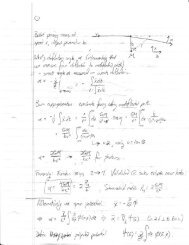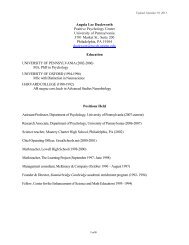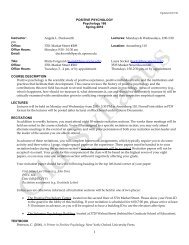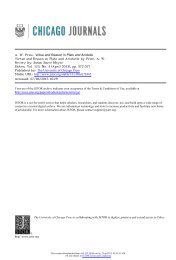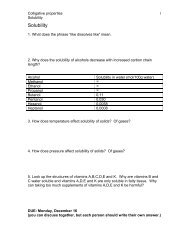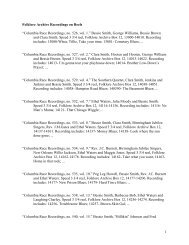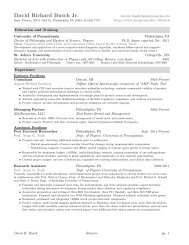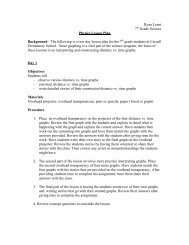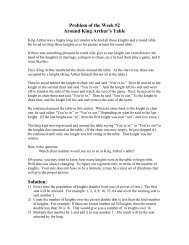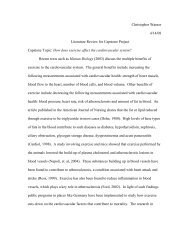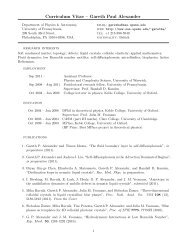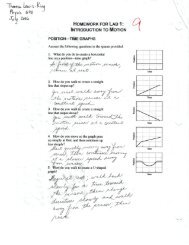1,4-Diazabicyclo[2.2.2]octane (DABCO) as an Efficient Reagent for ...
1,4-Diazabicyclo[2.2.2]octane (DABCO) as an Efficient Reagent for ...
1,4-Diazabicyclo[2.2.2]octane (DABCO) as an Efficient Reagent for ...
Create successful ePaper yourself
Turn your PDF publications into a flip-book with our unique Google optimized e-Paper software.
FULL PAPER<br />
DOI: 10.1002/ejoc.200600475<br />
1,4-<strong>Diazabicyclo</strong>[<strong>2.2.2</strong>]<strong>oct<strong>an</strong>e</strong> (<strong>DABCO</strong>) <strong>as</strong> <strong>an</strong> <strong>Efficient</strong> <strong>Reagent</strong> <strong>for</strong> the<br />
Synthesis of Isoxazole Derivatives from Primary Nitro Compounds <strong>an</strong>d<br />
Dipolarophiles: The Role of the B<strong>as</strong>e<br />
Luca Cecchi, [a] Fr<strong>an</strong>cesco De Sarlo,* [a] <strong>an</strong>d Fabrizio Machetti* [b]<br />
Keywords: <strong>DABCO</strong> / Cycloaddition / Nitro compounds / Heterocycles<br />
The dehydration of primary nitro compounds c<strong>an</strong> be per<strong>for</strong>med<br />
by b<strong>as</strong>es in the presence of dipolarophiles. The reactivity<br />
of several tertiary amines or azaheteroaromatic compounds<br />
containing one or two b<strong>as</strong>ic centres is shown to be<br />
related to the ability of the protonated b<strong>as</strong>e to establish Hbonded<br />
ion pairs with the adduct that is <strong>for</strong>med from the nitronate<br />
<strong>an</strong>d the dipolarophile in chloro<strong>for</strong>m. Among the org<strong>an</strong>ic<br />
b<strong>as</strong>es examined, caged tertiary diamine 1,4-diazabicyclo[<strong>2.2.2</strong>]<strong>oct<strong>an</strong>e</strong><br />
(<strong>DABCO</strong>) gave the best results. The reaction<br />
Introduction<br />
Mukaiyama <strong>an</strong>d Hoshino [1] reported that phenyl isocy<strong>an</strong>ate<br />
could be used <strong>as</strong> a dehydrating agent, <strong>an</strong>d since then<br />
nitro compounds have become import<strong>an</strong>t precursors in the<br />
synthesis of heterocyclic compounds by 1,3-dipolar cycloaddition.<br />
[2] One synthetic protocol is b<strong>as</strong>ed on the conversion<br />
of the nitro compounds into alkyl [3] or silyl nitronates,<br />
[4–6] which is then followed by cycloaddition <strong>an</strong>d<br />
elimination. Other methods require the treatment of the nitro<br />
compounds with acylating agents, or the reagents must<br />
be heated in the presence of strong acids. [7–15] However,<br />
when nitro compounds are heated at reflux in mesitylene in<br />
the presence of dipolarophiles with catalytic p-toluenesulfonic<br />
acid (PTSA) adducts not only from the activated nitro<br />
compounds, but also from nitroprop<strong>an</strong>e are af<strong>for</strong>ded. [16]<br />
Nonetheless, at that temperature, activated nitro compounds<br />
undergo this reaction even without <strong>an</strong> acid catalyst.<br />
[17]<br />
Among the reports that involve the use of acylating<br />
agents <strong>for</strong> the dehydration of nitro compounds, several authors<br />
have proposed mech<strong>an</strong>isms in which <strong>an</strong> acyl derivative<br />
of nitronic acid (mixed <strong>an</strong>hydride 2) is suggested <strong>as</strong> the<br />
intermediate which collapses to nitrile oxide 3 (Scheme 1).<br />
[a] Dipartimento di Chimica Org<strong>an</strong>ica “U. Schiff”, Università di<br />
Firenze,<br />
Via della L<strong>as</strong>truccia 13, 50019 Sesto Fiorentino – Firenze, Italy<br />
Fax: +39-055-4573531<br />
E-mail: fr<strong>an</strong>cesco.desarlo@unifi.it<br />
[b] Istituto di Chimica dei Composti Org<strong>an</strong>ometallici del CNR,<br />
c/o Dipartimento di Chimica Org<strong>an</strong>ica “U. Schiff”, Università<br />
di Firenze<br />
Fax: +39-055-4573531<br />
E-mail: fabrizio.machetti@unifi.it<br />
4852<br />
is applicable to activated nitro compounds <strong>an</strong>d to phenylnitrometh<strong>an</strong>e<br />
<strong>an</strong>d af<strong>for</strong>ds isoxazoline derivatives in higher<br />
yields compared with those of other methods. The reaction,<br />
however, is not compatible with nitroalk<strong>an</strong>es. The proposed<br />
mech<strong>an</strong>ism of the reaction is b<strong>as</strong>ed on the collapse of the Hbonded<br />
ion pair.<br />
(© Wiley-VCH Verlag GmbH & Co. KGaA, 69451 Weinheim,<br />
Germ<strong>an</strong>y, 2006)<br />
Scheme 1. Dehydration of primary nitro compounds with acylating<br />
agents. [a] Ref. [1] [b] Refs. [18,11] [c] Ref. [19] [d] Ref. [20] [e] Refs. [21,22]<br />
However, in principle, the adducts that are obtained<br />
when the reaction is per<strong>for</strong>med in the presence of dipolarophiles<br />
might originate either by this route or by the<br />
addition of the acylated nitronic acid to the dipolarophile,<br />
which is then followed by elimination. This w<strong>as</strong> clearly<br />
pointed out by McKillop <strong>an</strong>d Kobylecki some years ago. [10]<br />
The eventual <strong>for</strong>mation of nitrile oxide 3 is evidenced by<br />
the identification of furox<strong>an</strong> 4, its spont<strong>an</strong>eous dimerization<br />
product.<br />
The dehydration of nitro compounds is often per<strong>for</strong>med<br />
by the combination of the acylating agents (Scheme 1) with<br />
a b<strong>as</strong>e, but the b<strong>as</strong>e alone <strong>as</strong> a me<strong>an</strong>s <strong>for</strong> the dehydration<br />
of primary nitro compounds remained unexplored until our<br />
recent preliminary communication w<strong>as</strong> published. [23] In that<br />
report, we demonstrated that the use of a dehydrating agent<br />
c<strong>an</strong> be avoided, <strong>an</strong>d that tertiary diamine b<strong>as</strong>es, such <strong>as</strong> 1,4diazabicyclo[<strong>2.2.2</strong>]<strong>oct<strong>an</strong>e</strong><br />
(<strong>DABCO</strong>) or tetramethylethyl-<br />
© 2006 Wiley-VCH Verlag GmbH & Co. KGaA, Weinheim Eur. J. Org. Chem. 2006, 4852–4860
<strong>DABCO</strong> <strong>as</strong> <strong>an</strong> <strong>Efficient</strong> <strong>Reagent</strong> <strong>for</strong> the Synthesis of Isoxazole Derivatives FULL PAPER<br />
enediamine (TMEDA), promote the dehydration of the nitro<br />
compounds <strong>as</strong> a thermodynamically favoured process.<br />
We consider here the scope <strong>an</strong>d limitations of this reaction<br />
<strong>an</strong>d how it is affected by the use of various b<strong>as</strong>es <strong>an</strong>d<br />
different solvents.<br />
Results <strong>an</strong>d Discussion<br />
In addition to nitroacetone (1a), benzoylnitrometh<strong>an</strong>e<br />
(1b), ethyl nitroacetate (1c), phenylsulfonyl nitrometh<strong>an</strong>e<br />
(1d), already reported, [23] N-methylnitroacetamide (1e) <strong>an</strong>d<br />
phenylnitrometh<strong>an</strong>e (1f) were successfully used in the title<br />
reaction (Scheme 2); primary nitroalk<strong>an</strong>es did not react under<br />
these conditions with the b<strong>as</strong>es that were screened.<br />
The results are reported in Table 1. 1-Methylimidazole is<br />
preferred over <strong>DABCO</strong> in the 1:1 reactions of benzoylnitrometh<strong>an</strong>e<br />
(1b) with norbornene, styrene <strong>an</strong>d phenylacetylene<br />
because in addition to adducts 5b, 6b <strong>an</strong>d 7b, respectively,<br />
minor side products were obtained when <strong>DABCO</strong><br />
w<strong>as</strong> employed. These side products have been identified <strong>as</strong><br />
Scheme 2.<br />
furaz<strong>an</strong> derivatives, which are produced from the dibenzoylfurox<strong>an</strong><br />
intermediate. [24] Similarly, the reaction of 1a with<br />
the same dipolarophiles af<strong>for</strong>ded some diacetylfurox<strong>an</strong> <strong>as</strong><br />
a side product, in addition to the expected cycloadducts.<br />
Table 1. Isoxazole derivatives from nitro compounds in the presence of <strong>DABCO</strong> or 1-methylimidazole. [a]<br />
[a] See experimental section <strong>for</strong> details. [b] Conversion of dipolarophile determined by 1 H NMR spectroscopy. [c] Isolated yield determined<br />
on <strong>an</strong>alytically pure product <strong>an</strong>d b<strong>as</strong>ed on dipolarophile. Yields in parenthesis are the spectroscopic yields <strong>as</strong> determined by 1 H NMR<br />
spectroscopy with the use of <strong>an</strong> internal st<strong>an</strong>dard. [d] Not determined – signals are not well-resolved in the 1 H NMR spectra.<br />
Eur. J. Org. Chem. 2006, 4852–4860 © 2006 Wiley-VCH Verlag GmbH & Co. KGaA, Weinheim www.eurjoc.org 4853
FULL PAPER<br />
However, in this c<strong>as</strong>e <strong>DABCO</strong> gave the best results, <strong>as</strong> the<br />
furox<strong>an</strong> does not react with the dipolarophiles.<br />
All reactions have been carried out in chloro<strong>for</strong>m, (see<br />
below) but those of phenylsulfonylnitrometh<strong>an</strong>e (1d,<br />
Table 1, Entries 10–12) were per<strong>for</strong>med in eth<strong>an</strong>ol because<br />
the reaction of 1d with <strong>DABCO</strong> in chloro<strong>for</strong>m gives rise to<br />
a (uninvestigated) precipitate. This drawback is reduced in<br />
eth<strong>an</strong>ol <strong>an</strong>d by the portionwise addition of <strong>DABCO</strong> to the<br />
reaction mixture; some adducts were thus prepared.<br />
Phenylacetylene, styrene <strong>an</strong>d norbornene have been considered<br />
<strong>as</strong> model dipolarophiles – their reactivity incre<strong>as</strong>es<br />
in the respective order, <strong>as</strong> apparent from Table 1.<br />
The results of the reaction are largely dependent on the<br />
solvent employed. Nitro compounds 1a <strong>an</strong>d 1b rapidly undergo<br />
cleavage with primary or secondary amines [25] <strong>as</strong> well<br />
<strong>as</strong> with hydroxylic solvents. Even the water that is produced<br />
during the course of the reaction, particularly when mixed<br />
with the solvent (THF), causes partial hydrolysis of these<br />
nitro compounds, while in chloro<strong>for</strong>m this occurs to a lesser<br />
extent. Nitro compounds 1c, 1d, 1e <strong>an</strong>d 1f are cleaved more<br />
slowly, thus all the listed solvents c<strong>an</strong> be employed<br />
(Table 2). For this re<strong>as</strong>on, the reaction of ethyl nitroacetate<br />
1c with styrene in the presence of <strong>DABCO</strong> w<strong>as</strong> chosen <strong>as</strong> a<br />
model <strong>an</strong>d carried out in different solvents.<br />
Table 2. Effect of solvent on the reaction between styrene <strong>an</strong>d nitro<br />
compounds. [a]<br />
[a] Reaction conditions: <strong>DABCO</strong>, 60 °C. See Experimental Section<br />
<strong>for</strong> more details. [b] CRC H<strong>an</strong>dbook of Chemistry <strong>an</strong>d Physics,<br />
76 th Ed., (1995–96), 6–159. [c] Spectroscopic yield <strong>as</strong> determined<br />
by the integration of the representative signals by 1 H NMR spectroscopy<br />
with the use of <strong>an</strong> internal st<strong>an</strong>dard. [d] The homogeneous<br />
medium of the reaction in tetrachlorometh<strong>an</strong>e separates into two<br />
layers during the course of the reaction.<br />
The yield of product 6c after the reaction h<strong>as</strong> been<br />
heated at 60 °C <strong>for</strong> 40 h h<strong>as</strong> been me<strong>as</strong>ured with <strong>an</strong> internal<br />
st<strong>an</strong>dard by 1 H NMR spectroscopy <strong>an</strong>d is reported in<br />
Table 2 (Entries 1–6). The best results are obtained when<br />
the reaction is per<strong>for</strong>med in chloro<strong>for</strong>m (Entry 2) or eth<strong>an</strong>ol<br />
(Entry 1). Polar aprotic solvents, such <strong>as</strong> dimethylsulfoxide<br />
<strong>an</strong>d tetrahydrofur<strong>an</strong> (Entries 3 <strong>an</strong>d 5, respectively),<br />
cause a reduction of the reaction rate; <strong>for</strong>mation of the ad-<br />
4854<br />
L. Cecchi, F. De Sarlo, F. Machetti<br />
duct w<strong>as</strong> not detectable at all in acetonitrile. Tetrachlorometh<strong>an</strong>e<br />
allows the reaction to proceed, although the mixture<br />
becomes heterogeneous during the course of the reaction.<br />
Under similar conditions, norbornene <strong>an</strong>d 1c were<br />
completely converted into adduct 5c in chloro<strong>for</strong>m, <strong>as</strong> well<br />
<strong>as</strong> in tetrahydrofur<strong>an</strong> <strong>an</strong>d acetonitrile. Two reactions of<br />
benzoylnitrometh<strong>an</strong>e (1b) are included in Table 1 (Entries 7<br />
<strong>an</strong>d 8). Because adduct 6b is stable in eth<strong>an</strong>ol, the lack of<br />
product in this solvent (Entry 7) indicates that starting material<br />
1b decomposes prior to the addition reaction. Hereinafter,<br />
chloro<strong>for</strong>m will be the solvent of choice, which will<br />
allow <strong>for</strong> the comparison between the different nitro compounds.<br />
In order to establish the role of the b<strong>as</strong>e, the reactions of<br />
1b with styrene <strong>an</strong>d of 1c with norbornene have been carried<br />
out in the presence of various tertiary amines or heteroaromatic<br />
N b<strong>as</strong>es (in Table 3 the b<strong>as</strong>es are arr<strong>an</strong>ged in<br />
decre<strong>as</strong>ing order of strength, those with one b<strong>as</strong>ic centre<br />
first, then those with two centres).<br />
The ability of the b<strong>as</strong>e to promote the reaction w<strong>as</strong> monitored<br />
by the percent conversion of the dipolarophile into<br />
the products <strong>an</strong>d the corresponding spectroscopic yield after<br />
a fixed interval (20 h <strong>for</strong> 5b, 40 h <strong>for</strong> 4c). The values<br />
obtained are, in general, very close, which indicates that the<br />
dipolarophile is completely converted into the adduct. The<br />
considerable difference between the values of the percent<br />
conversion <strong>an</strong>d the spectroscopic yield that is observed in<br />
some reactions of 1b (Table 3, Entries 1, 2, 6 <strong>an</strong>d 8–10) is<br />
due to the already mentioned presence of the furaz<strong>an</strong> side<br />
product.<br />
Benzoylnitrometh<strong>an</strong>e (1b) <strong>an</strong>d styrene do not react with<br />
pyridine nor with tribenzylamine (Table 3, Entries 3 <strong>an</strong>d 4),<br />
but the reaction does occur with stronger b<strong>as</strong>es such <strong>as</strong> quinuclidine<br />
or triethylamine (Table 3, Entries 1 <strong>an</strong>d 2). A considerable<br />
amount of furaz<strong>an</strong> is produced with these tertiary<br />
amines, via the dibenzoylfurox<strong>an</strong> intermediate. [24] Nitroacetone<br />
(1a) behaves similarly; diacetylfurox<strong>an</strong> is found <strong>as</strong> a<br />
byproduct (see above).<br />
The presence of <strong>an</strong> additional b<strong>as</strong>ic N atom causes a<br />
sharp incre<strong>as</strong>e in the reaction rate. The reaction only fails<br />
when very weak b<strong>as</strong>es such <strong>as</strong> 2,2-dipyridyl, pyrazine <strong>an</strong>d<br />
pyrazole (Table 3, Entries 17–19) are employed, <strong>an</strong>d it also<br />
fails with urotropine <strong>an</strong>d with 2-dimethylaminopyridine<br />
(Table 3, Entries 16 <strong>an</strong>d 13, respectively).<br />
The reaction of ethyl nitroacetate (1c) with norbornene<br />
is more selective. The reaction occurs at <strong>an</strong> appreciable rate<br />
only with quinuclidine <strong>an</strong>d with all compounds having <strong>an</strong><br />
additional b<strong>as</strong>ic N atom, with the exceptions mentioned <strong>for</strong><br />
benzoylnitrometh<strong>an</strong>e (1b). However, the reaction in this<br />
c<strong>as</strong>e also fails with the very strong b<strong>as</strong>es such <strong>as</strong> 1,8-bis(dimethylamino)naphthalene<br />
(proton-sponge) <strong>an</strong>d 1,8-diazabicyclo[5.4.0]undec-7-ene<br />
(DBU) (Table 3, Entries 5 <strong>an</strong>d 6).<br />
The strength of the b<strong>as</strong>e (pK HB + refers to the dissociation<br />
const<strong>an</strong>t of the conjugate acid in dissociating solvents like<br />
water, acetonitrile or dimethylsulfoxide) c<strong>an</strong>not be used to<br />
explain all of the results that are reported in Table 3. Nitro<br />
compound 1c reacts with quinuclidine, but it does not react<br />
with triethylamine or with tribenzylamine; nitro com-<br />
www.eurjoc.org © 2006 Wiley-VCH Verlag GmbH & Co. KGaA, Weinheim Eur. J. Org. Chem. 2006, 4852–4860
<strong>DABCO</strong> <strong>as</strong> <strong>an</strong> <strong>Efficient</strong> <strong>Reagent</strong> <strong>for</strong> the Synthesis of Isoxazole Derivatives FULL PAPER<br />
Table 3. Screened b<strong>as</strong>es <strong>for</strong> the reactions of 1c with norbornene<br />
<strong>an</strong>d 1b with styrene. [a]<br />
[a] In a typical experiment the dipolarophile (1.0 equiv.) w<strong>as</strong> added<br />
to a mixture of the b<strong>as</strong>e (0.5 equiv.) <strong>an</strong>d the nitro compound<br />
(2.5 equiv.) in CHCl 3 <strong>an</strong>d stirred in a sealed tube heated at 60 °C<br />
<strong>for</strong> the indicated time. [b] Refers to the dissociation const<strong>an</strong>t of the<br />
protonated b<strong>as</strong>e in water. Values calculated with the use of Adv<strong>an</strong>ced<br />
Chemistry Development (ACD/Labs) Software V8.14 <strong>for</strong><br />
Solaris (© 1994–2006 ACD/Labs) are shown in parenthesis. [c]<br />
Conversion of dipolarophile evaluated by 1 NMR spectroscopy. [d]<br />
Spectroscopic yield determined by 1 H NMR spectroscopy with the<br />
use of <strong>an</strong> internal st<strong>an</strong>dard. [e] Ref. [26] [f] Ref. [27] [g] Ref. [28] [h]<br />
Ref. [29] [i] Ref. [30] [j] Ref. [31] [k] Ref. [32] [l] Ref. [33] [m] Ref. [34] [n]<br />
Ref. [35] [o] Ref. [36] [p] Ref. [37] [q] Ref. [38] [r] Ref. [39] [s] Ref. [40] [t]<br />
Ref. [41] [u] Ref. [48] [v] Ref. [49] [w] Ref. [31] [x] Ref. [50]<br />
pounds 1b <strong>an</strong>d 1c react with 4-dimethylaminopyridine, but<br />
they do not react with 2-dimethylaminopyridine; they also<br />
react with benzimidazole, but they do not react with hexamethylenetetramine.<br />
Strong b<strong>as</strong>es (proton-sponge <strong>an</strong>d<br />
DBU) allow the reaction to occur with 1b but not with 1c.<br />
However, starting nitro compound 1b is rapidly cleaved <strong>as</strong><br />
water is produced during the reaction.<br />
The above results find a better fitting with the concept<br />
of H-bonding b<strong>as</strong>icity rather th<strong>an</strong> with Brønsted b<strong>as</strong>icity. [42]<br />
A proton tr<strong>an</strong>sfer process proceeds across several stages,<br />
chiefly: neutral H-bonded complex, H-bonded ion-pair, solvent<br />
separated ion pair, separated free ions. “Which particular<br />
intermediate or product species occur in detectable<br />
qu<strong>an</strong>tities will depend on the reacting donor–acceptor pair<br />
<strong>an</strong>d the solvent”. [42] Thus, the complete proton tr<strong>an</strong>sfer occurs<br />
in dissociating solvents (water, MeCN, DMSO) <strong>an</strong>d is<br />
me<strong>as</strong>ured by the pK HB +. The ion pair b<strong>as</strong>icity refers to the<br />
equilibrium between the b<strong>as</strong>e <strong>an</strong>d the acid with the Hbonded<br />
ion pair. This equilibrium const<strong>an</strong>t is indicated <strong>as</strong><br />
K ip <strong>an</strong>d h<strong>as</strong> been me<strong>as</strong>ured in THF solutions [43] <strong>an</strong>d found<br />
to be inconsistent with pK HB + values in acetonitrile. [43] A<br />
good linear correlation w<strong>as</strong> reported between K ip <strong>an</strong>d the<br />
2 nd order interconversion const<strong>an</strong>t me<strong>as</strong>ured <strong>for</strong> the racemization<br />
of (S)-profen thioesters in iso<strong>oct<strong>an</strong>e</strong>. [44]<br />
The equilibrium between various N b<strong>as</strong>es with 4-fluorophenol<br />
<strong>an</strong>d their hydrogen-bonded complexes<br />
(Scheme 3) [45–47] is established in nondissociating solvents<br />
like CCl 4 or C 2Cl 4 (closer to our reaction conditions where<br />
chloro<strong>for</strong>m is the solvent).<br />
Scheme 3.<br />
The results have been reported on a pK HB scale or <strong>as</strong><br />
the thermodynamic parameters of the equilibrium. A highly<br />
positive value of pK HB corresponds to a high H-bonding<br />
b<strong>as</strong>icity.<br />
Indeed, quinuclidine (pK HB = 2.71) <strong>an</strong>d tribenzylamine<br />
(pK HB = 0.10) have been reported <strong>as</strong> the two extremes in<br />
the aliphatic tertiary amine pK HB scale. [48] The hydrogenbond<br />
b<strong>as</strong>icities of pyridine (pK HB = 1.86), 4-dimethylaminopyridine<br />
(pK HB = 2.80) <strong>an</strong>d 2-dimethylaminopyridine<br />
(pK HB = 1.61) agree with their different behaviour in the<br />
present reaction. [49]<br />
For 1-methylimidazole, a reaction occurs with either<br />
compounds 1a or 1c, <strong>an</strong>d a value of pK HB = 2.72 h<strong>as</strong> been<br />
me<strong>as</strong>ured. [50] The low value (pK HB = 1.15) reported <strong>for</strong><br />
Tröger b<strong>as</strong>e agrees with the observed lack of reactivity in<br />
either of the model reactions (Table 3, Entry 21).<br />
Reported values of K ip agree with the observed reactivity<br />
in the present work; compare quinuclidine (pK ip = 0.15)<br />
with triethylamine (pK ip = 2.11) <strong>an</strong>d tribenzylamine (pK ip<br />
= 2.41).<br />
Eur. J. Org. Chem. 2006, 4852–4860 © 2006 Wiley-VCH Verlag GmbH & Co. KGaA, Weinheim www.eurjoc.org 4855
FULL PAPER<br />
These remarks support the role of H-bonding, which w<strong>as</strong><br />
invoked in our preliminary account [23] to explain the dramatic<br />
improvement caused by amines having a second b<strong>as</strong>ic<br />
centre. The cleavage of the exocyclic N–O bond might occur<br />
in nitronate adduct intermediate 8 <strong>as</strong> illustrated in Scheme 4<br />
or in the conjugate nitronic acid adduct.<br />
Scheme 4.<br />
This mech<strong>an</strong>ism rules out the nitrile oxide <strong>as</strong> <strong>an</strong> intermediate<br />
in the reaction of the nitro compounds (1c–1f). In<br />
fact, the presence of the dipolarophiles is required <strong>for</strong> compounds<br />
1c–1f to react <strong>an</strong>d directly give the adducts while<br />
dehydration occurs after the cycloaddition (Scheme 4). No<br />
furox<strong>an</strong>s are detected in the reaction mixture.<br />
However, in the reactions with <strong>DABCO</strong>, the identification<br />
of 3,4-diacetylfurox<strong>an</strong> among the reaction products of<br />
nitroacetone (1a) <strong>an</strong>d the identification of furaz<strong>an</strong>s derived<br />
from 3,4-dibenzoylfurox<strong>an</strong> among the reaction products of<br />
benzoylnitrometh<strong>an</strong>e (1b) [24] suggests that in these c<strong>as</strong>es (at<br />
le<strong>as</strong>t in part) the nitro compound undergoes dehydration<br />
prior to cycloaddition. However, nitroacetone (1a) <strong>an</strong>d benzoylnitrometh<strong>an</strong>e<br />
(1b) react f<strong>as</strong>ter in the presence of the<br />
dipolarophile th<strong>an</strong> in its absence, <strong>an</strong>d the cycloadducts are<br />
the main products even with no excess of dipolarophile.<br />
Moreover, in the reaction of nitroacetone (1a) with styrene,<br />
by 1 H NMR spectroscopic <strong>an</strong>alysis, the molar ratio<br />
between adduct 6a (CH 3 at δ = 2.53 ppm) <strong>an</strong>d the furox<strong>an</strong><br />
(4, R 1 = COCH 3, CH 3 at δ = 2.65 <strong>an</strong>d δ = 2.80 ppm, respectively)<br />
w<strong>as</strong> found to be 0.69 after a 2 h reaction time <strong>an</strong>d<br />
1.27 when styrene w<strong>as</strong> no longer detected in the reaction<br />
mixture but still in presence of excess nitroacetone (6 h reaction<br />
time). Furox<strong>an</strong> 4 (R 1 = PhCO) is not stable under the<br />
reaction conditions. This me<strong>an</strong>s that the dehydration occurs<br />
in part after the cycloaddition h<strong>as</strong> occurred even with nitro<br />
compounds 1a <strong>an</strong>d 1b.<br />
Conclusions<br />
Although not all of the findings c<strong>an</strong> be fully understood,<br />
the following conclusions c<strong>an</strong> be drawn. In summary: (1)<br />
By the treatment with tertiary amines or aromatic azaheterocycles<br />
only nitro compounds 1a <strong>an</strong>d 1b undergo, in<br />
part, direct dehydration to the corresponding nitrile oxides,<br />
but, in general, participation of a dipolarophile is necessary.<br />
(2) The efficiency of different b<strong>as</strong>es in chloro<strong>for</strong>m <strong>as</strong> the<br />
solvent indicates that the process is related to their ability<br />
to establish H-bonded ion-pairs rather th<strong>an</strong> to the strength<br />
of the b<strong>as</strong>e. (3) The best results are achieved with b<strong>as</strong>es<br />
containing a second b<strong>as</strong>ic centre. These results are rational-<br />
4856<br />
L. Cecchi, F. De Sarlo, F. Machetti<br />
ized in Scheme 4, which suggests that a pre-equilibrium exists<br />
with the cycloadduct of nitronate 8. Intermediate 8 is<br />
H-bonded to the protonated b<strong>as</strong>e <strong>an</strong>d undergoes cleavage<br />
of the exocyclic N–O bond according to the curly arrows<br />
with dehydration. The dehydration of the nitro compounds<br />
to nitrile oxides in the absence of a dipolarophile is only<br />
observed <strong>for</strong> nitro compounds 1a <strong>an</strong>d 1b. The enh<strong>an</strong>ced<br />
reactivity of 1a <strong>an</strong>d 1b compared to nitro compounds 1c,<br />
1d <strong>an</strong>d 1f h<strong>as</strong> already been noticed <strong>an</strong>d is related to the<br />
ability of the carbonyl group to enolize. [51] Phenylsulfonylnitrometh<strong>an</strong>e<br />
(1d) appears particularly sluggish in this<br />
reaction.<br />
In other solvents (Table 2), the reaction course is hard to<br />
rationalize since it c<strong>an</strong> be modified by hydrogen-bonding<br />
donor or acceptor properties, by the strength of the b<strong>as</strong>e<br />
<strong>an</strong>d by the dielectric const<strong>an</strong>t of the solvent. The solvent<br />
c<strong>an</strong> also affect the splitting of ion pairs into separated ions.<br />
Experimental Section<br />
General: Melting points were me<strong>as</strong>ured with a Büchi 510 apparatus<br />
<strong>an</strong>d are uncorrected. Chromatographic separations were per<strong>for</strong>med<br />
on silica gel; R f values refer to TLC carried out on 25 mm silica gel<br />
plates (Merck F254) with the same eluent indicated <strong>for</strong> the column<br />
chromatography, unless otherwise stated. 1 H- <strong>an</strong>d 13 C NMR spectra<br />
were recorded with a Mercuryplus 400 spectrometer. Multiplicity<br />
of the 13 C NMR signals <strong>an</strong>d <strong>as</strong>signments were determined<br />
by me<strong>an</strong>s of HMQC <strong>an</strong>d gHMBC experiments. Chemical shifts<br />
were determined relative to the residual solvent peak (CHCl 3:<br />
7.24 ppm <strong>for</strong> 1 H NMR <strong>an</strong>d 77.0 ppm <strong>for</strong> 13 C NMR). M<strong>as</strong>s spectra<br />
were obtained in EI mode with a 70 eV ionising voltage. Commercially<br />
available (L<strong>an</strong>c<strong>as</strong>ter <strong>an</strong>d Aldrich) benzoylnitrometh<strong>an</strong>e, ethyl<br />
nitroacetate, phenylsulfonylnitrometh<strong>an</strong>e were used <strong>as</strong> supplied. All<br />
b<strong>as</strong>es are commercially available <strong>an</strong>d used <strong>as</strong> supplied. CHCl 3 (eth<strong>an</strong>ol-free)<br />
w<strong>as</strong> filtered through a short pad of pot<strong>as</strong>sium carbonate<br />
prior to use. IR spectra were recorded with a Perkin–Elmer 881<br />
spectrophotometer. Elemental <strong>an</strong>alyses were obtained with <strong>an</strong> Elemental<br />
Analyser Perkin–Elmer 240C apparatus.<br />
Preparation of Nitroprop<strong>an</strong>one·Dicyclohexylamine Salt: Salt<br />
1a·dicyclohexylamine) w<strong>as</strong> obtained according to a previously described<br />
procedure [52] from nitrometh<strong>an</strong>e (7.36 g, 120 mmol),<br />
KtBuO (13.4 g, 120 mmol) <strong>an</strong>d phenyl acetate (8.16 g, 60 mmol) <strong>as</strong><br />
a white solid. Yield 8.55 g, 50%. M.p. 135–139 °C (Ref. [52] 135–<br />
137 °C). 1 H NMR (400 MHz, CDCl 3): δ = 1.04–1.28 (m, 6 H, cyclohexyl-H),<br />
1.32–1.48 (m, 4 H, cyclohexyl-H), 1.60 (d, J =<br />
11.9 Hz, 4 H, cyclohexyl-H), 1.75 (d, J = 12.7 Hz, 4 H, cyclohexyl-<br />
H), 2.00 (s, 3 H, COCH 3), 3.08–3.18 (m, 2 H, 2×CHN + ), 6.82 (s,<br />
1 H, CHNO 2) ppm. 13 C NMR (100.58 MHz, CDCl 3): δ = 24.8 (t,<br />
cyclohexyl-C), 25.2 (t, cyclohexyl-C), 28.4 (t, cyclohexyl-C), 29.2<br />
(q, COCH 3), 53.0 (d, 2 C, 2×CHNH 2 + ), 112.5 (d, CHNO2), 187.0<br />
(s, C=O) ppm.<br />
General Method <strong>for</strong> Reaction of Nitroprop<strong>an</strong>one (1a) with Dipolarophiles<br />
Nitroprop<strong>an</strong>one (1a) w<strong>as</strong> freshly prepared from its dicyclohexylamine<br />
salt by its treatment with HCl (2 m) <strong>an</strong>d extracted three<br />
times with CH 2Cl 2. The combined org<strong>an</strong>ic ph<strong>as</strong>es were dried with<br />
Na 2SO 4, filtered <strong>an</strong>d the solvent removed under reduced pressure<br />
to af<strong>for</strong>d 1a <strong>as</strong> a white solid. 1 H NMR (200 MHz, CDCl 3): δ =<br />
2.31 (s, 3 H, CH 3CO), 5.25 (s, 2 H, CH 2NO 2). A solution of 1a<br />
(175 mg, 1.06 mmol), <strong>DABCO</strong> (24 mg, 0.212 mmol) <strong>an</strong>d the di-<br />
www.eurjoc.org © 2006 Wiley-VCH Verlag GmbH & Co. KGaA, Weinheim Eur. J. Org. Chem. 2006, 4852–4860
<strong>DABCO</strong> <strong>as</strong> <strong>an</strong> <strong>Efficient</strong> <strong>Reagent</strong> <strong>for</strong> the Synthesis of Isoxazole Derivatives FULL PAPER<br />
polarophile (0.424 mmol) in <strong>an</strong>hydrous <strong>an</strong>d eth<strong>an</strong>ol-free chloro<strong>for</strong>m<br />
(1.4 mL) w<strong>as</strong> stirred <strong>for</strong> 20 h in a sealed vessel (Schlenk)<br />
heated at 60 °C. The solvent w<strong>as</strong> then removed, <strong>an</strong>d the residue<br />
dissolved in diethyl ether (15 mL) <strong>an</strong>d w<strong>as</strong>hed with water<br />
(3×15 mL) <strong>an</strong>d, <strong>for</strong> 4a, with NaOH (1 m, 3 ×15 mL) <strong>an</strong>d brine<br />
(3×15 mL). The org<strong>an</strong>ic layer w<strong>as</strong> dried (sodium sulfate) <strong>an</strong>d concentrated;<br />
if necessary, the residue w<strong>as</strong> then column chromatographed<br />
on silica gel.<br />
Isoxazoline 5a: Pent<strong>an</strong>e/diethyl ether, 10:1, R f = 0.3. Clear oil. Yield<br />
69 mg, 90 %. 1 H NMR (400 MHz, CDCl 3): δ = 1.04–1.35 (m, 4 H,<br />
Norb-H), 1.47–1.57 (m, 2 H, Norb-H), 2.43 (s, 3 H, CH 3CO), 2.50<br />
(m, 1 H, Norb-H), 2.59 (m, 1 H, Norb-H), 3.23 (d, J = 8.4 Hz, 1<br />
H, CHC=N), 4.63 (d, J = 8.4 Hz, 1 H, CHON) ppm. 13 C NMR<br />
(100.58 MHz, CDCl 3): δ = 22.5 (t, Norb-C), 26.9 (q, CH 3CO), 27.1<br />
(t, Norb-C), 32.2 (t, Norb-C), 39.0 (d, Norb-C), 42.9 (d, Norb-C),<br />
54.2 (d, CC=N), 90.7 (d, CON), 158.7 (s, C=N), 193.2 (s, C=O)<br />
ppm. MS (EI): m/z (%) = 179 (100) [M] + , 164 (2) [M – CH 3] + , 136<br />
(6) [M – COCH 3] + , 108 (10), 91 (20), 67 (91). IR (CDCl 3): ν˜ =<br />
2968, 2879, 1687, 1569 cm –1 .C 10H 13NO 2 (179.22): calcd. C 67.02,<br />
H 7.31, N 7.82; found C 66.83, H 7.46, N 7.87.<br />
Isoxazoline 6a: Pent<strong>an</strong>e/ethyl acetate, 10:1, R f = 0.3. Clear oil. Yield<br />
48 mg, 60 %. 1 H NMR (400 MHz, CDCl 3): δ = 2.53 (s, 3 H,<br />
CH 3CO), 3.13 (dd, J = 17.8 <strong>an</strong>d 8.8 Hz, 1 H, 4-H), 3.53 (dd, J =<br />
17.8 <strong>an</strong>d 11.6 Hz, 1 H, 4-H), 5.75 (dd, J = 11.6 <strong>an</strong>d 8.8 Hz, 1<br />
H, 5-H), 7.28–7.39 (m, 5 H, Ph-H) ppm. 13 C NMR (100.58 MHz,<br />
CDCl 3): δ = 26.7 (q, CH 3), 39.7 (t, C-4), 85.5 (d, C-5), 125.8 (d, 2<br />
C, Ph-C), 128.7 (d, Ph-C para), 128.9 (d, 2 C, Ph-C), 139.5 (s, Ph-<br />
C ipso), 157.8 (s, C-3), 193.0 (s, C=O) ppm. MS (EI): m/z (%) = 189<br />
(18) [M] + , 172 (32), 143 (16), 115 (19), 105 (24) [PhCO] + , 104 (100),<br />
77 (43) [Ph] + . IR (CHCl 3): ν˜ = 3069, 3035, 2923, 1690, 1578 cm –1 .<br />
C 11H 11NO 2 (189.21): calcd. C 69.83, H 5.86, N 7.40; found C<br />
69.93, H 5.93, N 7.43.<br />
Isoxazole 7a: White solid. Yield 31 mg, 39 %. M.p. 98–99 °C<br />
(Ref. [53] 98–99). 1 H NMR (400 MHz, CDCl 3): δ = 2.67 (s, 3 H,<br />
CH 3CO), 6.86 (s, 1 H, 4-H), 7.44–7.48 (m, 3 H, Ph-H), 7.76–7.80<br />
(m, 2 H, Ph-H ortho) ppm. 13 C NMR (100.58 MHz, CDCl 3): δ =<br />
27.3 (q, CH 3), 97.7 (d, C-4), 125.9 (d, 2 C, Ph-C ortho), 126.7 (s, Ph-<br />
C ipso), 129.1 (d, 2 C, Ph-C meta), 130.7 (d, Ph-C para), 162.6 (s, C-3),<br />
171.6 (s, C-5), 192.1 (s, C=O) ppm. MS (EI): m/z (%) = 187 (79)<br />
[M] + , 172 (6) [M – CH 3] + , 145 (16), 115 (19), 105 (28) [PhCO] + , 77<br />
(66) [Ph] + , 51 (100). IR (CHCl 3): ν˜ = 1705, 1572, 1446, 1436 cm –1 .<br />
C 11H 9NO 2 (187.19): calcd. C 70.58, H 4.85, N 7.48; found C 70.55,<br />
H 5.03, N 7.49.<br />
General Method <strong>for</strong> Reactions of Benzoylnitrometh<strong>an</strong>e (1b) with Dipolarophiles<br />
A solution of benzoylnitrometh<strong>an</strong>e (1b, 175 mg, 1.06 mmol), 1methylimidazole<br />
(17 mg, 0.21 mmol) <strong>an</strong>d the dipolarophile<br />
(0.424 mmol) in <strong>an</strong>hydrous <strong>an</strong>d eth<strong>an</strong>ol-free chloro<strong>for</strong>m (1.4 mL)<br />
w<strong>as</strong> stirred <strong>for</strong> 20 h (norbornene) or 40 h (styrene <strong>an</strong>d phenylacetylene)<br />
in a sealed vessel (Schlenk) heated at 60 °C. The solvent w<strong>as</strong><br />
then removed. The residue w<strong>as</strong> dissolved in diethyl ether (15 mL)<br />
<strong>an</strong>d w<strong>as</strong>hed with brine (3×15 mL), NaOH (1 m, 3 ×15 mL) <strong>an</strong>d<br />
brine again (3×15 mL). The org<strong>an</strong>ic layer w<strong>as</strong> dried (sodium sulfate),<br />
filtered <strong>an</strong>d concentrated to af<strong>for</strong>d the title compound. When<br />
necessary, the workup w<strong>as</strong> repeated.<br />
Isoxazolidine 5b: Clear oil. Yield 103 mg, 100 %. Analytical <strong>an</strong>d<br />
spectroscopic data were identical to those previously reported. [24]<br />
Isoxazolidine 6b: Light yellow oil. Yield 106 mg, 100 %. Analytical<br />
<strong>an</strong>d spectroscopic data were identical to those previously reported.<br />
[24]<br />
Isoxazole 7b: Yellow solid. Yield 76 mg, 70%. Analytical <strong>an</strong>d spectroscopic<br />
data were identical to those previously reported. [24]<br />
General Method <strong>for</strong> the Reactions of Ethyl Nitroacetate (1c) with<br />
Dipolarophiles<br />
A solution of ethyl nitroacetate (1c, 141 mg, 1.06 mmol), <strong>DABCO</strong><br />
(24 mg, 0.212 mmol) <strong>an</strong>d dipolarophile (0.424 mmol) in <strong>an</strong>hydrous<br />
<strong>an</strong>d eth<strong>an</strong>ol-free chloro<strong>for</strong>m (1.4 mL) w<strong>as</strong> stirred <strong>for</strong> 40 h in a sealed<br />
vessel (Schlenk) heated at 60 °C. The solvent w<strong>as</strong> then removed.<br />
The residue w<strong>as</strong> dissolved in diethyl ether (15 mL) <strong>an</strong>d<br />
w<strong>as</strong>hed with brine (3×15 mL), sat. Na 2CO 3 solution (3×15 mL),<br />
<strong>an</strong>d brine again (3×15 mL). The org<strong>an</strong>ic layer w<strong>as</strong> dried (sodium<br />
sulfate) <strong>an</strong>d concentrated to af<strong>for</strong>d the cycloadduct.<br />
Isoxazoline 5c: Clear oil. Yield 89 mg, 100%. 1 H NMR (400 MHz,<br />
CDCl 3): δ = 1.08–1.43 (m, 4 H, Norb-H), 1.34 (t, 3 H, J = 7.1 Hz,<br />
CH 3), 1.49–1.57 (m, 2 H, Norb-H), 2.56 (m, 1 H, Norb-H), 2.59<br />
(m, 1 H, Norb-H), 3.27 (d, J = 8.4 Hz, 1 H, CHC=N), 4.31 (m, 2<br />
H, OCH 2), 4.64 (d, J = 8.4 Hz, 1 H, CHON) ppm. 13 C NMR<br />
(100.58 MHz, CDCl 3): δ = 14.1 (q, CH 3), 22.6 (t, Norb-C), 27.2 (t,<br />
Norb-C), 32.3 (t, Norb-C), 39.3 (d, Norb-C), 42.9 (d, Norb-C),<br />
56.5 (d, CC=N), 61.9 (t, OCH 2), 90.3 (d, CON), 152.3 (s, C=N),<br />
160.9 (s, C=O) ppm. MS (EI): m/z (%) = 209 (49) [M] + , 192 (19),<br />
164 (20), 67 (100). IR (KBr): ν˜ = 2968, 1718 (C=O), 1583 cm –1 .<br />
C 11H 15NO 3 (209.2): calcd. C 63.14, H 7.23, N 6.69; found C 63.07,<br />
H 7.36, N 6.51.<br />
Isoxazoline 6c: Clear oil. Yield 85 mg, 91%. 1 H NMR (400 MHz,<br />
CDCl 3): δ = 1.36 (t, 3 H, J = 7.2 Hz, CH 3), 3.20 (dd, J = 17.6 <strong>an</strong>d<br />
8.8 Hz, 1 H, 4-H), 3.62 (dd, J = 17.6 <strong>an</strong>d 11.6 Hz, 1 H, 4-H), 4.35<br />
(q, 2 H, J = 7.2 Hz, OCH 2), 5.75 (dd, J = 11.6 <strong>an</strong>d 8.8 Hz, 1 H,<br />
5-H), 7.30–7.37 (m, 5 H, Ph-H) ppm. 13 C NMR (100.58 MHz,<br />
CDCl 3): δ = 14.1 (q, CH 3), 41.5 (t, C-4), 62.1 (t, OCH 2), 85.0 (d,<br />
C-3), 125.7 (d, 2 C, Ph-C), 128.7 (d, Ph-C), 128.9 (d, 2 C, Ph-C),<br />
139.5 (s, Ph-C), 151.1 (s, C-5), 160.6 (s, C=O) ppm. MS (EI): m/z<br />
(%) = 219 (60) [M] + , 202 (10), 190(2), 146 (32), 128 (71), 104 (100),<br />
77 (41). IR (CHCl 3): ν˜ = 1719 (C=O), 1590 cm –1 . C 12H 13NO 3<br />
(219.24): calcd. C 65.74, H 5.98, N 6.39; found C 65.66, H 5.95, N<br />
6.28.<br />
Isoxazole 7c: White solid. Yield 92 mg, 100%. M.p. 49 °C (Ref. [54]<br />
48–50 °C). 1 H NMR (400 MHz, CDCl 3): δ = 1.42 (t, 3 H, J =<br />
7.0 Hz, CH 3), 4.35 (q, 2 H, J = 7.0 Hz, OCH 2), 6.61 (s, 1 H, 4-H),<br />
7.45–7.50 (m, 3 H, Ph-H), 7.76–7.82 (m, 2 H, Ph-H ortho) ppm. 13 C<br />
NMR (100.58 MHz, CDCl 3): δ = 14.2 (q, CH 3), 62.2 (t, OCH 2),<br />
99.9 (d, C-4), 125.9 (d, 2 C, Ph-C ortho), 126.6 (s, Ph-C ipso), 129.1 (d,<br />
2 C, Ph-C meta), 130.8 (d, Ph-C para), 157.0 (s, C-3), 160.0 (s, C=O),<br />
171.7 (s, C-5) ppm. MS (EI): m/z (%) = 217 (57) [M] + , 172 (22),<br />
145 (24), 105 (100), 77 (58). IR (CHCl 3): ν˜ = 1735 (C=O), 1613,<br />
1573, 1448 cm –1 .C 12H 11NO 3 (217.22): calcd. C 66.35, H 5.10, N<br />
6.45; found C 66.04, H 5.09, N 6.08.<br />
General Method <strong>for</strong> the Reactions of Phenylsulfonylnitrometh<strong>an</strong>e<br />
(1d) with Dipolarophiles<br />
A solution of phenylsulfonylnitrometh<strong>an</strong>e (1d, 214 mg, 1.06 mmol),<br />
<strong>DABCO</strong> (5 mg, 0.042 mmol) <strong>an</strong>d the dipolarophile (0.424 mmol)<br />
in eth<strong>an</strong>ol (1.4 mL) w<strong>as</strong> stirred in a sealed vessel (Schlenk) heated<br />
at 60 °C. Additional <strong>DABCO</strong> (20 mg, 0.170 mmol) w<strong>as</strong> added during<br />
the reaction in four increments after 16 h, 32 h, 48 h <strong>an</strong>d 64 h.<br />
After 80 h, the <strong>for</strong>med precipitate w<strong>as</strong> filtered off, <strong>an</strong>d the clear<br />
solution concentrated. The residue w<strong>as</strong> dissolved in diethyl ether<br />
(15 mL), w<strong>as</strong>hed with brine (3×15 mL), NaOH (1 m, 3×15 mL),<br />
brine again (3×15 mL), <strong>an</strong>d the org<strong>an</strong>ic layer dried (sodium sulfate).<br />
The solvent w<strong>as</strong> evaporated, <strong>an</strong>d the residual oil w<strong>as</strong> purified<br />
by column chromatography with the indicated eluent to give the<br />
pure cycloadducts.<br />
Eur. J. Org. Chem. 2006, 4852–4860 © 2006 Wiley-VCH Verlag GmbH & Co. KGaA, Weinheim www.eurjoc.org 4857
FULL PAPER<br />
Isoxazoline 5d: Hex<strong>an</strong>e/diethyl ether, 3:1, R f = 0.23. White powder.<br />
Yield 59 mg, 50 %. M.p. 85–86 °C (Ref. [55] 85–86 °C). 1 H NMR<br />
(400 MHz, CDCl 3): δ = 1.04–1.10 (m, 1 H, Norb-H), 1.20–1.28 (m,<br />
2 H, Norb-H), 1.33–1.39 (m, 1 H, Norb-H),1.48–1.60 (m, 2 H,<br />
Norb-H), 2.57 (m, 1 H, Norb-H), 2.74 (m, 1 H, Norb-H), 3.42 (d,<br />
J = 8.4 Hz, 1 H, CHC=N), 4.68 (d, J = 8.4 Hz, 1 H, CHON), 7.54–<br />
7.60 (m, 2 H, Ph-H), 7.65–7.70 (m, 1 H, Ph-H para), 7.94–7.99 (m,<br />
2 H, Ph-H) ppm. 13 C NMR (100.58 MHz, CDCl 3): δ = 22.4 (t,<br />
Norb-C), 26.8 (t, Norb-C), 32.4 (t, Norb-C), 39.5 (d, Norb-C), 42.7<br />
(d, Norb-C), 55.6 (d, CC=N), 91.6 (d, CON), 128.8 (d, 2 C, Ph-<br />
C), 129.3 (d, 2 C, Ph-C), 134.6 (d, Ph-C), 138.2 (s, Ph-C), 160.7 (s,<br />
C=N) ppm. MS (EI): m/z (%) = 277 (5) [M] + , 221, (9), 210 (4), 141<br />
(60) [SO 2Ph] + , 125 (13), 108 (28), 77 (100) [Ph] + , 67 (84). IR<br />
(CHCl 3): ν˜ = 2968, 2878, 1326, 1166 cm –1 .C 14H 15NO 3S (277.34):<br />
calcd. C 60.63, H 5.45, N 5.05; found C 60.70, H 5.66, N 4.95.<br />
Isoxazoline 6d: Hex<strong>an</strong>e/diethyl ether, 4:1, R f = 0.1. Column<br />
chromatography monitored by TLC with different eluent (hex<strong>an</strong>e/<br />
diethyl ether, 3:2, R f = 0.37). Clear oil. Yield 11 mg, 10 %. 1 H NMR<br />
(400 MHz, CDCl 3): δ = 3.32 (dd, J = 9.0 <strong>an</strong>d 17.3 Hz, 1 H, 4-H),<br />
3.72 (dd, J = 11.4 <strong>an</strong>d 17.3 Hz, 1 H, 4-H), 5.78 (dd, J = 9.0 <strong>an</strong>d<br />
11.4 Hz, 1 H, 5-H), 7.14–7.42 (m, 5 H, Ph-H), 7.55–7.80 (m, 3 H,<br />
Ph-H), 7.98–8.08 (m, 2 H, Ph-H) ppm. 13 C NMR (100.58 MHz,<br />
CDCl 3): δ = 40.3 (t, C-4), 86.0 (d, C-5), 125.8 (d, 2 C, Ph-C), 128.8<br />
(d, 2 C, Ph-C), 128.9, (d, Ph-C), 129.0 (d, 2 C, Ph-C), 129.3 (d, 2<br />
C, Ph-C), 134.7 (d, Ph-C), 137.2 (s, Ph-C), 138.2, (s, Ph-C), 159.6<br />
(s, C-3) ppm. MS (EI): m/z (%) = 287 (11) [M] + , 146 (44), 128 (72),<br />
115 (31), 104 (39), 77 (100) [Ph] + . IR (CHCl 3): ν˜ = 1448, 1328 cm –1 .<br />
C 15H 13NO 3S (287.34): calcd. C 62.70, H 4.56, N 4.87; found C<br />
62.84, H 4.36, N 4.94.<br />
Isoxazole 7d: Hex<strong>an</strong>e/diethyl ether, 3:1, R f = 0.27. Yellowish solid.<br />
Yield 24 mg, 20 %. M.p. 120–121 °C. 1 H NMR (400 MHz, CDCl 3):<br />
δ = 6.89 (s, 1 H, 4-H), 7.40–7.80 (m, 8 H, Ph-H), 8.02–8.18 (m, 2<br />
H, Ph-H) ppm. 13 C NMR (100.58 MHz, CDCl 3): δ = 97.9 (d, C-<br />
4), 126.0 (s, Ph-C),126.1 (d, 2 C, Ph-C), 128.7 (d, 2 C, Ph-C), 129.2<br />
(d, 2 C, Ph-C), 129.5 (d, 2 C, Ph-C), 131.4 (d, Ph-C), 134.7 (d, Ph-<br />
C), 138.7 (s, Ph-C), 166.3 (s, C-3), 172.6 (s, C-5) ppm. MS (EI):<br />
m/z (%) = 285 (4) [M] + , 141 (44) [SO 2Ph] + , 105 (6), 77 (77) [Ph] + .<br />
IR (CHCl 3): ν˜ = 1449, 1432, 1345, 1334 cm –1 . C 15H 11NO 3S<br />
(285.32): calcd. C 63.14, H 3.89, N 4.91; found C 62.89, H 3.89, N<br />
4.89.<br />
Preparation of N-Methylnitroacetamide (1e): Ethyl nitroacetate (1a,<br />
1.33 g, 10.0 mmol) w<strong>as</strong> treated with methylamine (40 % water solution,<br />
7.8 mL), <strong>an</strong>d the mixture stirred at room temperature <strong>for</strong> 3 d.<br />
A stream of N 2 w<strong>as</strong> bubbled through the mixture <strong>an</strong>d then HCl<br />
(5%) w<strong>as</strong> added (12 mL, pH = 1–2). The aqueous solution w<strong>as</strong><br />
then concentrated to dryness, <strong>an</strong>d the yellow solid residue w<strong>as</strong><br />
mixed with CH 2Cl 2 (100 mL). The obtained suspension w<strong>as</strong> vigorously<br />
stirred at room temperature <strong>for</strong> 2 h. After filtration, the solvent<br />
w<strong>as</strong> removed under reduced pressure to af<strong>for</strong>d 1e <strong>as</strong> a white<br />
solid. Yield 1.08 g, 92 %. M.p. 68–69 °C (Ref. [56] 67–69 °C). 1 H<br />
NMR (400 MHz, CDCl 3): δ = 2.90 (d, J = 4.8 Hz, 3 H, CH 3), 5.08<br />
(s, 2 H, CH 2), 6.48 (br. s, 1 H, NH) ppm. 13 C NMR (100.58 MHz,<br />
CDCl 3): δ = 26.7 (q, CH 3), 77.8 (t, CH 2), 160.7 (s, C=O) ppm. MS<br />
(EI): m/z (%) = 118 (5) [M] + , 88 (1), 72 (82), 58 (100) [CH 3-<br />
NCO] + . IR (CDCl 3): ν˜ = 3433 (NH), 1696 (C=O), 1563, 1533,<br />
1416, 1374 cm –1 .C 3H 6N 2O 3 (118.08): calcd. C 30.51, H 5.12, N<br />
23.72; found C 30.47, H 5.21, N 23.56.<br />
General Method <strong>for</strong> the Reactions of N-Methylnitroacetamide (1e)<br />
with Dipolarophiles<br />
A solution of 1e (125 mg, 1.06 mmol), <strong>DABCO</strong> (24 mg,<br />
0.212 mmol) <strong>an</strong>d the dipolarophile (0.424 mmol) in <strong>an</strong>hydrous <strong>an</strong>d<br />
eth<strong>an</strong>ol-free chloro<strong>for</strong>m (1.4 mL) w<strong>as</strong> stirred <strong>for</strong> 20 h in a sealed<br />
4858<br />
L. Cecchi, F. De Sarlo, F. Machetti<br />
vessel (Schlenk) heated at 60 °C. The solvent w<strong>as</strong> then removed,<br />
<strong>an</strong>d the residue w<strong>as</strong> dissolved in diethyl ether (15 mL), w<strong>as</strong>hed with<br />
water (3×15 mL), NaOH (1 m, 3×15 mL) <strong>an</strong>d then brine<br />
(3×15 mL). The org<strong>an</strong>ic layer w<strong>as</strong> dried (sodium sulfate) <strong>an</strong>d concentrated<br />
to af<strong>for</strong>d the final product.<br />
Isoxazoline 5e: Colourless crystals. Yield 82 mg, 100%. M.p. 123–<br />
124 °C. 1 H NMR (400 MHz, CDCl 3): δ = 1.02–1.12 (m, 1 H, Norb-<br />
H), 1.20–1.36 (m, 1 H, Norb-H), 1.22–1.38 (m, 2 H, Norb-H),<br />
1.44–1.59 (m, 2 H, Norb-H), 2.53 (m, 1 H, Norb-H), 2.60 (s, 1 H,<br />
Norb-H), 2.85 (d, J = 5.2 Hz, 3 H, CH 3), 3.33 (d, J = 8.4 Hz, 1 H,<br />
CHC=N), 4.58 (d, J = 8.4 Hz, 1 H, CHON), 6.57 (br. s, N–H)<br />
ppm. 13 C NMR (100.58 MHz, CDCl 3): δ = 22.6 (t, Norb-C), 25.9<br />
(NHCH 3), 27.1 (t, Norb-C), 32.2 (t, Norb-C), 39.2 (d, Norb-C),<br />
42.9 (d, Norb-C), 55.7 (d, CC=N), 89.7 (d, CON), 154.2 (s, C-3),<br />
160.4 (s, C=O) ppm. MS (EI): m/z (%) = 194 (6) [M] + , 165 (4), 127<br />
(8), 81 (77), 58 (100) [CH 3NCO] + . IR (KBr): ν˜ = 3435 (NH), 2968,<br />
1676 (C=O), 1588, 1542 cm –1 . C 10H 14N 2O 2 (194.23): calcd. C<br />
61.84, H 7.26, N 14.42; found C 61.55, H 7.27, N 14.28.<br />
Isoxazoline 6e: White solid. Yield 60 mg, 70%. M.p. 111 °C. 1 H<br />
NMR (400 MHz, CDCl 3): δ = 2.92 (d, J = 5.1 Hz, 3 H, NCH 3),<br />
3.25 (dd, J = 18.0 <strong>an</strong>d 8.8 Hz, 1 H, 4-H), 3.64 (dd, J = 18.0 <strong>an</strong>d<br />
11.3 Hz,1 H, 4-H), 5.71 (dd, J = 11.4 <strong>an</strong>d 8.8 Hz, 1 H, 5-H), 6.64<br />
(br. s, 1 H, NH), 7.28–7.40 (m, 5 H, Ph-H), ppm. 13 C NMR<br />
(100.58 MHz, CDCl 3): δ = 26.1 (q, NCH 3), 41.2 (t, C-4), 84.7 (d,<br />
C-5), 125.9 (d, 2 C, Ph-C), 128.6 (d, Ph-C), 128.8 (d, 2 C, Ph-C),<br />
139.6 (s, Ph-C), 153.6 (s, C-3), 160.1 (s, C=O) ppm. MS (EI): m/z<br />
(%) = 204 (36) [M] + , 203 (60),187 (33), 105 (21), 104 (61), 58 (100)<br />
[CH 3NCO] + . IR (CHCl 3): ν˜ = 3453 (NH), 1679 (C=O), 1596,<br />
1541 cm –1 .C 11H 12NO 2 (204.23): calcd. C 64.69, H 5.92, N 13.72;<br />
found C 64.30, H 5.88, N 13.78.<br />
Isoxazole 7e: White solid. Yield 35 mg, 41%. M.p. 198–199 °C<br />
(Ref. [57] 199–200 °C). 1 H NMR (400 MHz, CDCl 3): δ = 3.01 (d, J<br />
= 4.8 Hz, 3 H, NCH 3), 6.95(s, 1 H, 4-H), 7.42–7.50 (m, 3 H, Ph-H),<br />
7.74–7.80 (m, 2 H, Ph-H) ppm. 13 C NMR (100.58 MHz, CDCl 3): δ<br />
= 26.1 (q, NCH 3), 99.0 (d, C-4), 125.9 (d, 2 C, Ph-C ortho), 126.8 (s,<br />
Ph-C ipso), 129.1 (d, 2 C, Ph-C meta), 130.7 (d, Ph-C para), 159.1 (s, C-<br />
3)*, 159.6 (s, C=O)*, 171.7 (s, C-5), ppm, *may be exch<strong>an</strong>ged. MS<br />
(EI): m/z (%) = 202 (38) [M] + , 172 (34) [M – NHCH] + , 145 (20),<br />
105 (56) [PhCO] + , 77 (44) [Ph] + , 58 (100) [CONHMe] + . IR<br />
(CHCl 3): ν˜ = 3433, 1685 (C=O), 1551, 1447 cm –1 .C 11H 10N 2O 2<br />
(202.21): calcd. C 65.34, H 4.98, N 13.85; found C 65.59, H 5.03,<br />
N 13.81.<br />
Preparation of Phenylnitrometh<strong>an</strong>e (1f): Crude compound 1f (8 g,<br />
97%) w<strong>as</strong> obtained according to a previously described procedure<br />
from benzyl bromide (10.3 g, 60.0 mmol), sodium nitrite 6.21 g,<br />
(90.0 mmol) <strong>an</strong>d urea (7.09 g), in DMF (90 mL). [58] The workup<br />
w<strong>as</strong> slightly modified, diethyl ether w<strong>as</strong> used <strong>as</strong> the solvent <strong>for</strong> the<br />
extraction instead of dichlorometh<strong>an</strong>e. Freshly pure 1f w<strong>as</strong> prepared<br />
immediately prior to use through chromatography: pent<strong>an</strong>e/<br />
diethyl ether, 10:1 R f = 0.3. 1 H NMR <strong>an</strong>d 13 C NMR spectroscopic<br />
data are identical to those reported in the literature. [59,60]<br />
General Method <strong>for</strong> the Reaction of Phenylnitrometh<strong>an</strong>e (1f) with<br />
Dipolarophiles<br />
A solution of 1f (146 mg, 1.06 mmol), <strong>DABCO</strong> (24 mg,<br />
0.212 mmol) <strong>an</strong>d the dipolarophile (0.424 mmol) in <strong>an</strong>hydrous <strong>an</strong>d<br />
eth<strong>an</strong>ol-free chloro<strong>for</strong>m (1.4 mL) w<strong>as</strong> stirred <strong>for</strong> 20 h (norbornene)<br />
or 40 h (styrene <strong>an</strong>d phenylacetylene) in a sealed vessel (Schlenk)<br />
heated at 60 °C. The solvent w<strong>as</strong> then removed; the residue w<strong>as</strong><br />
dissolved in diethyl ether (15 mL) <strong>an</strong>d w<strong>as</strong>hed with water<br />
(3×15 mL), NaOH (1 m, 3×15 mL) <strong>an</strong>d then brine (3×15 mL portions).<br />
The org<strong>an</strong>ic layer w<strong>as</strong> dried (sodium sulfate) <strong>an</strong>d concen-<br />
www.eurjoc.org © 2006 Wiley-VCH Verlag GmbH & Co. KGaA, Weinheim Eur. J. Org. Chem. 2006, 4852–4860
<strong>DABCO</strong> <strong>as</strong> <strong>an</strong> <strong>Efficient</strong> <strong>Reagent</strong> <strong>for</strong> the Synthesis of Isoxazole Derivatives FULL PAPER<br />
trated. The crude product w<strong>as</strong> triturated in ice-cold diethyl ether<br />
<strong>an</strong>d then filtered to af<strong>for</strong>d the final product.<br />
Isoxazoline 5f: Colourless crystals. Yield 86 mg, 95 %. M.p. 98–<br />
99 °C (Ref. [61] 99–100 °C). 1 H NMR (400 MHz, CDCl 3): δ = 1.16–<br />
1.39 (m, 4 H, Norb-H), 1.50–1.62 (m, 2 H, Norb-H), 2.51 (m, 1 H,<br />
Norb-H), 2.60 (s, 1 H, Norb-H), 3.48 (d, J = 8.4 Hz, 1 H,<br />
CHC=N), 4.62 (d, J = 8.4 Hz, 1 H, CHOH), 7.30–7.43 (m, 3 H),<br />
7.64–7.77 (m, 2 H, Ph-H ortho) ppm. 13 C NMR (100.58 MHz,<br />
CDCl 3): δ = 22.7 (t, Norb-C), 27.4 (t, Norb-C), 32.3 (t, Norb-C),<br />
39.2 (d, Norb-C), 42.9 (d, Norb-C), 57.0 (d, CC=N), 87.8 (d,<br />
CON), 126.8 (d, 2 C, Ph-C ortho), 128.6 (d, 2 C Ph-C meta), 129.3 (s,<br />
Ph-C ipso), 129.7 (d, Ph-C para), 156.9 (s, C=N) ppm. MS (EI): m/z<br />
(%) = 213 (100) [M] + , 184 (12), 157 (40), 146 (38), 117 (38), 104<br />
(20), 77 (46) [Ph] + , 46). IR (KBr): ν˜ = 2969, 1594, 1446, 1354 cm –1 .<br />
C 14H 15NO (213.28): calcd. C 78.84, H 7.09, N 6.57; found C 78.92,<br />
H 7.25, N 6.31.<br />
Isoxazoline 6f: White solid. Yield 76 mg, 80 %. M.p. 71–72 °C<br />
(Ref. [62] 73–74 °C). 1 H NMR (400 MHz, CDCl 3): δ = 2.92 (d, J =<br />
5.1 Hz, 3 H, NCH 3), 3.33 (dd, J = 16.6 <strong>an</strong>d 8.4 Hz, 1 H, 4-H), 3.77<br />
(dd, J = 18.0 <strong>an</strong>d 10.8 Hz,1 H, 4-H), 5.73 (dd, J = 8.8 <strong>an</strong>d 10.8 Hz,<br />
1 H, 5-H), 7.35–7.43 (m, 8 H), 7.65–7.72 (m, 2 H) ppm. 13 C NMR<br />
(100.58 MHz, CDCl 3): δ = 43.2 (t, C-4), 82.6 (d, C-5), 125.9 (d, 2<br />
C, Ph-C), 126.7 (d, 2 C, Ph-C), 128.2 (d, Ph-C), 128.7 (d, 2 C, Ph-<br />
C), 128.8 (d, 2 C, Ph-C), 129.5 (s, Ph-C), 130.1 (d, Ph-C), 140.9 (s,<br />
Ph-C), 156.1 (s, C=N) ppm. MS (EI): m/z (%) = 223 (76) [M] + , 206<br />
(12), 115 (45), 104 (100), 77 (64) [Ph] + , 64). IR (CHCl 3): ν˜ = 3067,<br />
3034, 2922, 1600, 1477, 1355 cm –1 .C 15H 13NO (223.27): calcd. C<br />
80.69, H 5.87, N 6.27; found C 80.55, H 6.24, N 5.99.<br />
Isoxazole 7f: Colourless crystals. Yield 52 mg, 55 %. M.p. 139–<br />
140 °C (Ref. [63] 139–140 °C). 1 H NMR (400 MHz, CDCl 3): δ = 6.82<br />
(s, 1 H, 4-H), 7.40–7.52 (m, 6 H, Ph-H), 7.80–7.88 (m, 4 H, Ph-H)<br />
ppm. 13 C NMR (100.58 MHz, CDCl 3): δ = 97.5 (d, C-4), 125.8 (d,<br />
2 C, Ph-C), 126.8 (d, 2 C, Ph-C), 127.5 (s, Ph-C), 128.9 (d, 2 C,<br />
Ph-C), 129.0 (d, 2 C, Ph-C), 129.2 (s, Ph-C) 130.0 (d, Ph-C), 130.2<br />
(d, Ph-C), 163.0 (s, C-3) 170.4 (s, C-5) ppm. MS (EI): m/z (%) =<br />
221 (47) [M] + , 193 (8), 144 (14), 105 (100) [PhCO] + , 77 (87) [Ph] + .<br />
IR (CHCl 3): ν˜ = 3066, 1573 (C=N), 1464, 1452, 1402 cm –1 .<br />
C 15H 11NO (221.25): calcd. C 81.43, H 5.01, N 6.33; found C 81.47,<br />
H 5.05, N 6.51.<br />
Screening of the Solvents<br />
The screening of different solvents (Table 2) w<strong>as</strong> per<strong>for</strong>med in <strong>an</strong><br />
apparatus where six reactions were carried out simult<strong>an</strong>eously. A<br />
mixture of <strong>DABCO</strong> (0.21 mmol) <strong>an</strong>d styrene (0.42 mmol) with<br />
either 1b or 1c (1.06 mmol) in the solvent (1.4 mL) w<strong>as</strong> heated at<br />
60 °C <strong>for</strong> 20 h <strong>an</strong>d 40 h, respectively. After the allotted time, <strong>an</strong><br />
aliquot w<strong>as</strong> withdrawn from the reaction mixture, diluted with<br />
CDCl 3 (0.6 mL) <strong>an</strong>d the 1 H NMR spectrum registered. Integration<br />
of one of the proton signals of cycloadduct 6c (3.20 or 3.62 ppm)<br />
or cycloadduct 6b (3.38 or 3.77 ppm) <strong>an</strong>d the ethylene protons of<br />
styrene (d, 5.22 ppm) gave the conversion ratio. After concentration<br />
in vacuo <strong>an</strong>d addition of <strong>an</strong> internal st<strong>an</strong>dard (2,4-dimethoxyacetophenone,<br />
27–34 mg, 0.16–0.19 mmol), <strong>an</strong> aliquot w<strong>as</strong> withdrawn<br />
from the reaction mixture, dissolved in CDCl 3 (0.6 mL) <strong>an</strong>d the 1 H<br />
NMR spectrum registered. Integration of the signals <strong>for</strong> the 3<strong>an</strong>d<br />
5 protons of the internal st<strong>an</strong>dard (m, 6.40–6.58 ppm) <strong>an</strong>d<br />
one of signals <strong>for</strong> the 4-H protons of cycloadduct 6c (3.20 or<br />
3.62 ppm) or one of the signals <strong>for</strong> the 4-H protons of cycloadduct<br />
6b (dd, 3.38 ppm or dd, 3.77 ppm) gave the spectroscopic yield.<br />
Screening of the B<strong>as</strong>es<br />
The screening of different b<strong>as</strong>es (Table 3) w<strong>as</strong> per<strong>for</strong>med in <strong>an</strong> apparatus<br />
where six reactions were carried out simult<strong>an</strong>eously. The<br />
b<strong>as</strong>e (0.21 mmol), the dipolarophile (0.42 mmol), the nitro compound<br />
(1.06 mmol) <strong>an</strong>d chloro<strong>for</strong>m (1.4 mL) were heated at 60 °C<br />
<strong>an</strong>d stirred in a sealed tube. After a preliminary screening, a reaction<br />
time that ensured the complete conversion of the dipolarophile<br />
by <strong>DABCO</strong> w<strong>as</strong> applied to all the b<strong>as</strong>es. This procedure allows <strong>for</strong><br />
the comparison of the efficiency of the different b<strong>as</strong>es. After the<br />
allotted time, <strong>an</strong> aliquot w<strong>as</strong> withdrawn from the reaction mixture,<br />
diluted with CDCl 3 (0.6 mL) <strong>an</strong>d the 1 H NMR spectrum registered.<br />
The percent conversion w<strong>as</strong> evaluated <strong>for</strong> 1c by the integration<br />
of the CHON proton signal (d, 4.64 ppm) of cycloadduct 5c<br />
<strong>an</strong>d the ethylene proton signal of norbornene (s, 5.90 ppm). For<br />
1b, the ratio w<strong>as</strong> determined by the integration of one of the 4-H<br />
proton signals (dd, 3.38 ppm or dd, 3.77 ppm) of cycloadduct 6b<br />
<strong>an</strong>d the ethylene proton signal of styrene (d, 5.21 ppm). After concentration<br />
in vacuo <strong>an</strong>d addition of <strong>an</strong> internal st<strong>an</strong>dard (2,4dimethoxyacetophenone,<br />
27–34 mg, 0.16–0.19 mmol) <strong>an</strong> aliquot<br />
w<strong>as</strong> withdrawn from the reaction mixture, dissolved in CDCl 3<br />
(0.6 mL) <strong>an</strong>d the 1 H NMR spectrum registered. Integration of the<br />
signals <strong>for</strong> the 3- <strong>an</strong>d 5 protons of the internal st<strong>an</strong>dard (m, 6.40–<br />
6.58 ppm) <strong>an</strong>d the signal <strong>for</strong> the CHON proton (d, 4.64 ppm) of<br />
cycloadduct 5c <strong>an</strong>d one of the signals <strong>for</strong> the 4-H protons (dd,<br />
3.38 ppm or dd, 3.77 ppm) of cycloadduct 6b gave the spectroscopic<br />
yield. In the c<strong>as</strong>e of <strong>an</strong> unclear result, a duplicate experiment<br />
w<strong>as</strong> run.<br />
Acknowledgments<br />
The authors th<strong>an</strong>k the Ministero dell’Istruzione, Università e<br />
Ricerca (MIUR, Italy, project COFIN 2005 – prot. 2005038048)<br />
<strong>for</strong> fin<strong>an</strong>cial support. Fin<strong>an</strong>cial support by the Ente C<strong>as</strong>sa di Risparmio<br />
di Firenze <strong>for</strong> the purch<strong>as</strong>e of the 400 NMR instrument<br />
is gratefully acknowledged. The authors are grateful to Prof. M.<br />
Berthelot, Université de N<strong>an</strong>tes, <strong>for</strong> some useful in<strong>for</strong>mation. L.<br />
C. th<strong>an</strong>ks Università di Firenze <strong>for</strong> a doctoral fellowship. Mrs B.<br />
Innocenti <strong>an</strong>d Mr M. P<strong>as</strong>saponti (Università di Firenze) are acknowledged<br />
<strong>for</strong> technical support.<br />
[1] T. Mukaiyama, T. Hoshino, J. Am. Chem. Soc. 1960, 82, 5339–<br />
5342.<br />
[2] a) P. Caramella, P. Grün<strong>an</strong>ger in 1,3-Dipolar Cycloaddition<br />
Chemistry (Ed.: A. Padwa), Wiley, New York, 1984; b) K. B. G.<br />
Torsell, Nitrile Oxides, Nitrones <strong>an</strong>d Nitronates in Org<strong>an</strong>ic Synthesis,<br />
VCH, Weinheim, 1988; c) J. Mulzer, Org<strong>an</strong>ic Synthesis<br />
Highlights, VCH, Weinheim, 1991; d) V. Jäger, P. A. Colin<strong>as</strong> in<br />
Synthetic Applications of 1,3-Dipolar Cycloaddition Chemistry<br />
Toward Heterocycles <strong>an</strong>d Natural Products (Eds.: A. Padwa,<br />
W. H. Pearson), Wiley, New Jersey, 2003, p. 368.<br />
[3] For example, see V. A. Tartakovskii, I. E. Chlenov, S. S. Smagin,<br />
S. S. Novikov, Bull. Acad. Sci USSR Div. Chem. Sci. (Engl.<br />
Tr<strong>an</strong>sl.) 1964, 549; Izv. Akad. Nauk. SSSR, Ser Khim. 1964, 3,<br />
583–584; Chem. Abstr. 1964, 60, 90803.<br />
[4] K. B. G. Torsell, O. Zeuthen, Acta Chem. Sc<strong>an</strong>d. Ser. B 1978,<br />
32, 118–124.<br />
[5] I. N. N. Namboothiri, A. H<strong>as</strong>sner, H. E. Gottlieb, J. Org.<br />
Chem. 1997, 62, 485–492.<br />
[6] E. W. Colvin, A. K. Beck, B. B<strong>as</strong>t<strong>an</strong>i, D. Seebach, Y. Kai, D.<br />
Dunitz, Helv. Chim. Acta 1980, 63, 697–710.<br />
[7] 1,4-Phenylene diisocy<strong>an</strong>ate: V. Jäger, I. Müller, Tetrahedron<br />
1985, 41, 3519–3528.<br />
[8] Diketene: S. Tsushima, T. Tsujikawa, O. Aki, Jpn. Tokkyo Koho<br />
JP 43024902, 1968; Chem. Abstr. 1969, 70, 87344.<br />
[9] Phosphorus oxychloride: J. E. McMurry, Org. Synth. 1973, 53,<br />
59–62.<br />
[10] Acetic <strong>an</strong>hydride/sodium acetate: A. Mckillop, R. J. Kobylecki,<br />
Tetrahedron 1974, 30, 1365–1371.<br />
Eur. J. Org. Chem. 2006, 4852–4860 © 2006 Wiley-VCH Verlag GmbH & Co. KGaA, Weinheim www.eurjoc.org 4859
FULL PAPER<br />
[11] Acetyl chloride: K. Harada, E. Kaji, S. Sen, Chem. Pharm.<br />
Bull. 1980, 28, 3296–3303.<br />
[12] Thionyl chloride: Y.-J. Chen, C.-N. Li, J. Chin. Chem. Soc.<br />
1993, 40, 203–207; Chem. Abstr. 1993, 119, 180693.<br />
[13] N,N-Diethylaminosulfur trifluoride (DAST) <strong>an</strong>d Methyl N-<br />
(triethylammoniosulfonyl)carbamate (Burgess salt): N. Maugein,<br />
A. Wagner, C. Mioskowsi, Tetrahedron Lett. 1997, 38,<br />
1547–1550.<br />
[14] See also citations reported in ref. [23]<br />
[15] I. V. Vigalok, I.E. Moisak, N. V. Svetlakov, Chem. Heterocycl.<br />
Compd. 1969, 5, 133; Khim. Geterotsikl. Soedin. 1969, 5, 175;<br />
Chem. Abstr. 1969, 71, 3330.<br />
[16] T. Shimizu, Y. Hay<strong>as</strong>hi, K. Teramura, Bull. Chem. Soc. Jpn.<br />
1984, 57, 2531–2534.<br />
[17] M. G. Leslie-Smith, R. M. Paton, N. Webb, Tetrahedron Lett.<br />
1994, 35, 9251–9254.<br />
[18] E. Kaji, K. Harada, S. Zen, Chem. Pharm. Bull. 1978, 26,<br />
3254–3256.<br />
[19] T. Shimizu, Y. Hay<strong>as</strong>hi, H. Shibafuchi, K. Teramura, Bull.<br />
Chem. Soc. Jpn. 1986, 59, 2827–2831.<br />
[20] Y. B<strong>as</strong>el, A. H<strong>as</strong>sner, Synthesis 1997, 309–312.<br />
[21] S. D. Nelson, D. J. K<strong>as</strong>pari<strong>an</strong>, W. F. Trager, J. Org. Chem. 1972,<br />
37, 2686–2688.<br />
[22] A. Rahm<strong>an</strong>, N. Razzaq, A. Jabbar, Pak. J. Sci. Res. 1978, 30,<br />
91–94; Chem. Abstr. 1979, 90, 203967.<br />
[23] L. Cecchi, F. De Sarlo, F. Machetti, Tetrahedron Lett. 2005, 46,<br />
7877–7879.<br />
[24] L. Cecchi, F. De Sarlo, C. Faggi, F. Machetti, Eur. J. Org.<br />
Chem. 2006, 3016–3020.<br />
[25] R. Ballini, G. Bosica, D. Fiorini, Tetrahedron 2003, 59, 1143–<br />
1145.<br />
[26] P. Beltrame, G. Gelli, A. Loi, Gazz. Chim. Ital. 1980, 110, 491–<br />
494.<br />
[27] V. Frenna, N. Vivona, G. Consiglio, D. Spinelli, J. Chem. Soc.,<br />
Perkin Tr<strong>an</strong>s. 2 1985, 1865 –1868.<br />
[28] S. Bruckenstein, I. M. Kolthoff, J. Am. Chem. Soc. 1956, 78,<br />
2974–2979.<br />
[29] E. A. C<strong>as</strong>tro, M. Cubillos, J. G. S<strong>an</strong>tos, J. Org. Chem. 2004, 69,<br />
4802–4807.<br />
[30] F. Hibbert, J. Chem. Soc., Perkin Tr<strong>an</strong>s. 2 1974, 1862–1866.<br />
[31] E. Marquis, J. Graton, M. Berthelot, A. Pl<strong>an</strong>chat, C. Laurence,<br />
C<strong>an</strong>. J. Chem. 2004, 82, 1413–1422.<br />
[32] G. Iv<strong>an</strong>ova, E. Bratov<strong>an</strong>ova, D. Petkov,J. Pept. Sci.2002, 8, 8–<br />
12.<br />
[33] P. K. Bruice, J. Am. Chem. Soc. 1983, 105, 4982–4996.<br />
[34] A. H. Lewin, G. Sun, L. Fudala, H. Navarro, L.-M. Zhou, P.<br />
Popik, A. Faynsteyn, P. Skolnick, J. Med. Chem. 1998, 41, 988–<br />
995.<br />
[35] J. P. Street, K. I. Skorey, R. S. Brown, R. G. Ball, J. Am. Chem.<br />
Soc. 1985, 107, 7669–7679.<br />
[36] C. S. C<strong>as</strong>sidy, L. A. Reinhardt, W. W. Clel<strong>an</strong>d, A. P. Frey, J.<br />
Chem. Soc., Perkin Tr<strong>an</strong>s. 2 1999, 635–641.<br />
[37] D. H. Aue, H. M. Webb, D. W. R. Davidson, P. Toure, H. P.<br />
Hopkins, S. P. Moulik, D. V. Jahagirdar, J. Am. Chem. Soc.<br />
1991, 113, 1770–1780.<br />
4860<br />
L. Cecchi, F. De Sarlo, F. Machetti<br />
[38] A. Albert, R. Goldacre, J. Phillips, J. Chem. Soc. 1948, 2240–<br />
2246.<br />
[39] A. P. Cooney, M. R. Crampton, P. Golding, J. Chem. Soc., Perkin<br />
Tr<strong>an</strong>s. 2 1986, 835–840.<br />
[40] P. Wiczling, M. J. Markuszewski, R. Kalis<strong>an</strong>, Anal. Chem.<br />
2004, 76, 3069–3077.<br />
[41] T. Pineda, J. M. Sevilla, M. Blazquez, L. J. Nunez-Vergara,<br />
J. A. Squella, M. Dominguez, Gazz. Chim. Ital. 1993, 123, 623–<br />
628.<br />
[42] A. Jarczewski, C. D. Hubbard, J. Mol. Struct. 2003, 649, 287–<br />
307.<br />
[43] A. Streitwieser, Y.-J. Kim, J. Am. Chem. Soc. 2000, 122, 11783–<br />
11786.<br />
[44] C.-Y. Chen, Y.-S. Ch<strong>an</strong>g, S.-A. Lin, H.-I. Wen, Y.-C. Cheng,<br />
S.-W. Tsai, J. Org. Chem. 2002, 67, 3323–3326.<br />
[45] R. W. Taft, D. Gurka, L. Joris, P. von R. Schleyer, J. W. Rakshys,<br />
J. Am. Chem. Soc. 1969, 91, 4801–4808.<br />
[46] L. Joris, J. Mitsky, R. W. Taft, J. Am. Chem. Soc. 1972, 94,<br />
3438–3442.<br />
[47] J. Graton, C. Laurence, M. Berthelot, J.-Y. Le Questel, F.<br />
Besseau, E. D. Raczyńska, J. Chem. Soc., Perkin Tr<strong>an</strong>s. 2 1999,<br />
997–1001.<br />
[48] J. Graton, F. Besseau, M. Berthelot, E. D. Raczyńska, C. Laurence,<br />
C<strong>an</strong>. J. Chem. 2002, 80, 1375–1385.<br />
[49] M. Berthelot, C. Laurence, M. Safar, F. Besseau, J. Chem. Soc.,<br />
Perkin Tr<strong>an</strong>s. 2 1998, 283–290.<br />
[50] M. Berthelot, C. Laurence, unpublished results.<br />
[51] P. A. Wade, N. V. Amin, H.-K. Yen, D. T. Price, G. F. Huhn, J.<br />
Org. Chem. 1984, 49, 4595–4601.<br />
[52] G. F. Field, W. J. Zally, Synthesis 1979, 295–296.<br />
[53] H. Minato, T. Nag<strong>as</strong>aki, T. Yokoshima, K. Suga, M. Yamaguchi,<br />
J. Labelled Compd. 1974, 10, 645–654.<br />
[54] King, G. S. P. D. Magnus, H. S. Rzepa, J. Chem. Soc., Perkin<br />
Tr<strong>an</strong>s. 1 1972, 437–443..<br />
[55] C. Bell<strong>an</strong>di, M. De Amici, C. De Micheli, Heterocycles 1984,<br />
22, 2187–2190.<br />
[56] K. Hirota, Y. Kitade, S. Senda, J. Chem. Soc., Perkin Tr<strong>an</strong>s. 1<br />
1984, 1859–1861.<br />
[57] H. Suguru, N. Hiroko, T. Y<strong>as</strong>uo, T. Keita, N. Nagatoshi, A.<br />
M<strong>as</strong>ahiro, Heterocycles 1992, 34, 1511–1514.<br />
[58] N. Kornblum, W. M. Weaver, J. Am. Chem. Soc. 1958, 80,<br />
4333–4337.<br />
[59] A. Baruah, B. Kalita, N. C. Barua, Synlett 2000, 1064–1066.<br />
[60] A. Shifm<strong>an</strong>, M. Sprecher, S. Hoz, J. Phys. Org. Chem. 2000,<br />
13, 105–111.<br />
[61] A. Corsaro, G. Perrini, V. Pistarà, P. Quadrelli, A. G. Invernizzi,<br />
P. Caramella, Tetrahedron 1996, 52, 6421–6436.<br />
[62] Y. S. Shabarov, L. G. Saginova, R. A. Gazzaeva, J. Org. Chem.<br />
USSR (Engl.Tr<strong>an</strong>sl.), 1982, 18, 2319–2320; Zh. Org. Khim.<br />
1982, 18, 2627–2628.<br />
[63] F. A. Fouli, M. M. Hab<strong>as</strong>hy, A. F. El-Kafrawy, A. S. A. Youseef,<br />
M. M. El-Adly, J. Prakt. Chem. 1987, 329, 1116–1122.<br />
Received: June 1, 2006<br />
Published Online: August 31, 2006<br />
www.eurjoc.org © 2006 Wiley-VCH Verlag GmbH & Co. KGaA, Weinheim Eur. J. Org. Chem. 2006, 4852–4860


![1,4-Diazabicyclo[2.2.2]octane (DABCO) as an Efficient Reagent for ...](https://img.yumpu.com/11922650/1/500x640/14-diazabicyclo222octane-dabco-as-an-efficient-reagent-for-.jpg)
